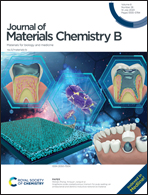Efficient suppression of amyloid-β peptide aggregation and cytotoxicity with photosensitive polymer nanodots†
Abstract
The deposition of amyloid plaques resulting from the aggregation of amyloid-β (Aβ) peptides is closely related to Alzheimer's disease (AD). With the development of various therapeutic methods, the oxidative modification of Aβ has emerged as a fascinating noninvasive photo-therapeutic intervention for treating AD by altering the Aβ aggregation tendency. Herein, we report the photo-triggered inhibition of Aβ aggregation and cytotoxicity by utilizing polymer nanodots (Pdots) modified with rose bengal (RB), methylene blue (MB), and riboflavin (RF). Experimental results demonstrate that these functionalized Pdots manifest a superior suppression effect on Aβ aggregation under irradiation. This can be attributed to the formation of reactive oxygen species (ROS) (i.e., singlet oxygen (1O2)), resulting in the oxygenation of Aβ and the change of Aβ aggregation tendency. Especially, RB-Pdots manifest better biocompatibility and higher 1O2 productivity. In a word, this hybridized nanostructure will provide a promising platform for the noninvasive photo-therapeutic treatment of AD in the future.



 Please wait while we load your content...
Please wait while we load your content...